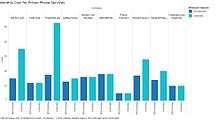Inmate telephone system
Inmate telephone systems are telecommunications systems designed for use in correctional facilities. Ideally, telephone service for inmates allows for their rehabilitation by allowing consistent communication with family and legal counsel while incarcerated,[1] while also allowing the facility's staff to record and monitor the inmate's telephone activities.[2]
Inmate telephone systems have been frequently criticized for having significantly higher rates than typical phone services—a practice stemming from commissions paid to facilities as part of exclusive contracts to provide these services. In the United States, the Federal Communications Commission began to address these issues in 2014 by implementing caps on phone rates for interstate phone calls to and from correctional facilities.
Operation
Inmate telephone systems are typically provided by specialized firms. In the United States, the market is dominated by two providers, Global Tel-Link and Securus Technologies, with Global Tel-Link controlling approximately 50% of the market and Securus with 20%.[3] Facilities enter into exclusive concession contracts with a specific company to provide these services for all their inmates, typically favoring the provider that can provide larger commissions to the facility via their service fees.[3]
Generally, prison systems limit the calls to a fifteen minute maximum, and inmates have to wait thirty minutes before being allowed to make another call, though the call limitations vary depending on the prison's house rules.[4] In many prisons, phone credits are accessed via an inmate account card.[5] Inmates have to register to be able to use the service,[6] and need to provide a list with names and numbers of people they will be allowed to call.[7]
Service rates
In the United States, service rates for phone calls within jails were similar to those available to the general public through commercial providers.[3] Since the 1990's, jail phone service providers traditionally charged higher rates for the phone services than traditional home phone service. In some cases, long-distance calls are charged six times the rate on the outside, or in other instances, a fifteen-minute call could cost upwards of $15.[8] The exorbitant rates are typically meant to compensate for the high commissions paid to the facilities the provider serves. These practices have been frequently criticized by the families of inmates, who feel that these providers had exploited their personal situations in order to turn a profit.[3][9] Corrections facilities and law enforcement agencies typically resisted attempts to lower these fees, arguing that they provide additional funding to support a facility's operations, such as security.[3][9]
In 2013, the Federal Communications Commission released an analysis on jail telephone service providers, arguing that these phone rates had "caused inmates and their friends and families to subsidize everything from inmate welfare to salaries and benefits, states’ general revenue funds and personnel training". The FCC announced that it had proposed capping the charge for interstate inmate phone calls at $3.75 for 15 minutes.[10] The proposal was approved in 2014; a cap was also implemented to reduce the high long-distance charges that inmates incurred to eleven cents per minute,[11] so that a fifteen-minute call should not cost more than $4. According to the FCC, Global Tel-Link had been charging as much as $17.30 for such calls under contracts with facilities in Arkansas, Georgia and Minnesota, which resulted in "unreasonably high" phone bills for inmates' families.[10] In retaliation for the change, service providers raised the rates on local calls.[3]

References
- ↑ Fred Mosely; Charles Sullivan: Using Inmate Calling Services for Rehabilitation, Offender Programs Report: Social and Behavioral Rehabilitation in Prisons, Jails and the Community Volume:5 Issue:5 Dated:January/February 2002 Pages:65-66, to 74
- ↑ Bell, William R. (2002). Practical criminal investigations in correctional facilities. CRC Press. p. 196. ISBN 978-0-8493-1194-9.
- 1 2 3 4 5 6 Timothy Williams (30 March 2015). "The High Cost of Calling the Imprisoned". The New York Times. Retrieved 22 June 2016.
- ↑ Frantz, Michael (2009). Jail Time: What You Need to Know...Before You Go to Federal Prison!. Dog Ear Publishing. p. 156. ISBN 978-1-59858-935-1.
- ↑ Bosworth, Mary (2002). The U.S. federal prison system. SAGE. pp. 177, 178, 222. ISBN 978-0-7619-2304-6.
- ↑ Williams, Stephen P. (2006). How to be a Hollywood star: your guide to living the fabulous life. Random House. p. 69. ISBN 978-0-307-33622-4.
- ↑ Hanrahan, Clare (2005). Conscience & Consequence: A Prison Memoir. Celtic Wordcraft. p. 34. ISBN 978-0-9758846-1-4.
- ↑ "FCC Reduces High Long-Distance Calling Rates Paid by Inmates". Federal Communication Commission. Federal Communication Commission. Retrieved 20 November 2015.
- 1 2 "Serial's $2,500 Phone Bill and the Prison-Calling Racket". Bloomberg. Retrieved 11 July 2016.
- 1 2 Ryan Dezember (17 April 2014). "American Securities Puts Prison-Phone Operator GTL on Block". Wall Street Journal. Retrieved 22 June 2016.
- ↑ "Rates for Interstate Inmate Calling Services". Federal Communication Commission. Retrieved 20 November 2015.
External links
- Securus Technologies
- GlobalTel Jail Calls
- Federal Communications Commission
- ATIS Telecom Glossary
- Inmate Telephone Service - Guide to inmate telephone systems, services and providers
- Inmate Telephone Service - Finding a jail phone provider
- Telewest Inmate Phones
- Jail Phone Service Guide
- Prison Phone Service Overview
- Pigeonly